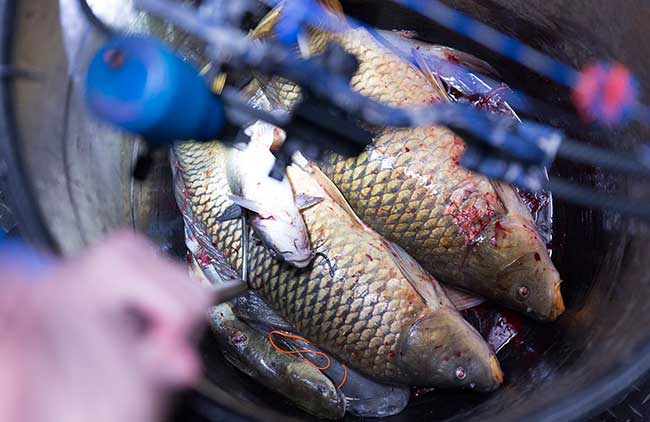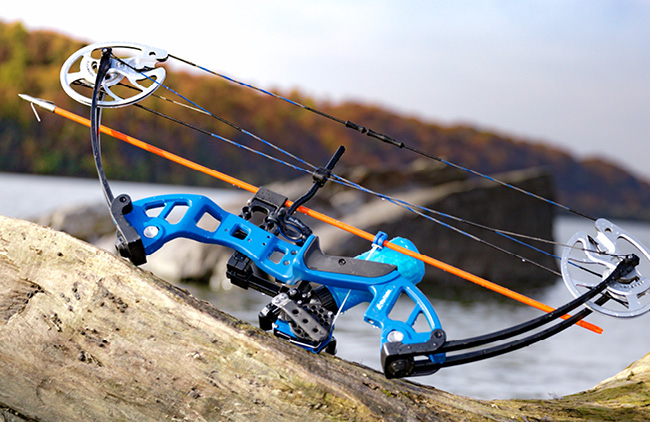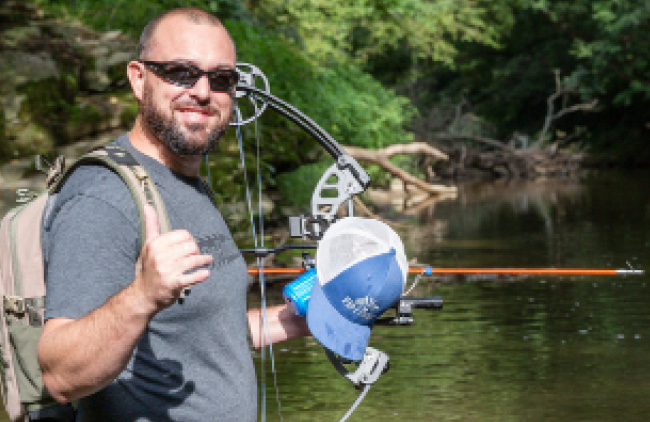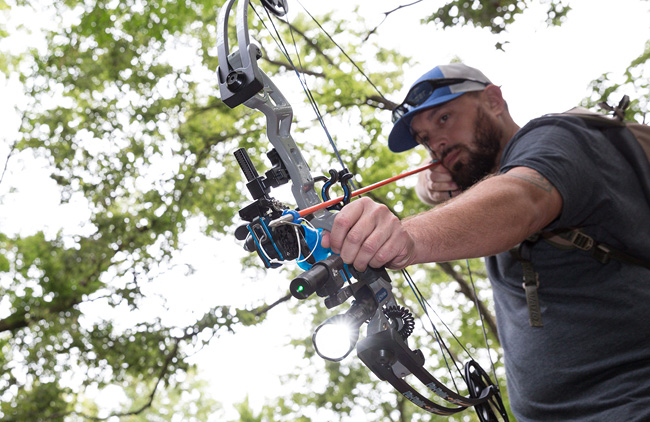Best Bowfishing Sights and Aiming Methods
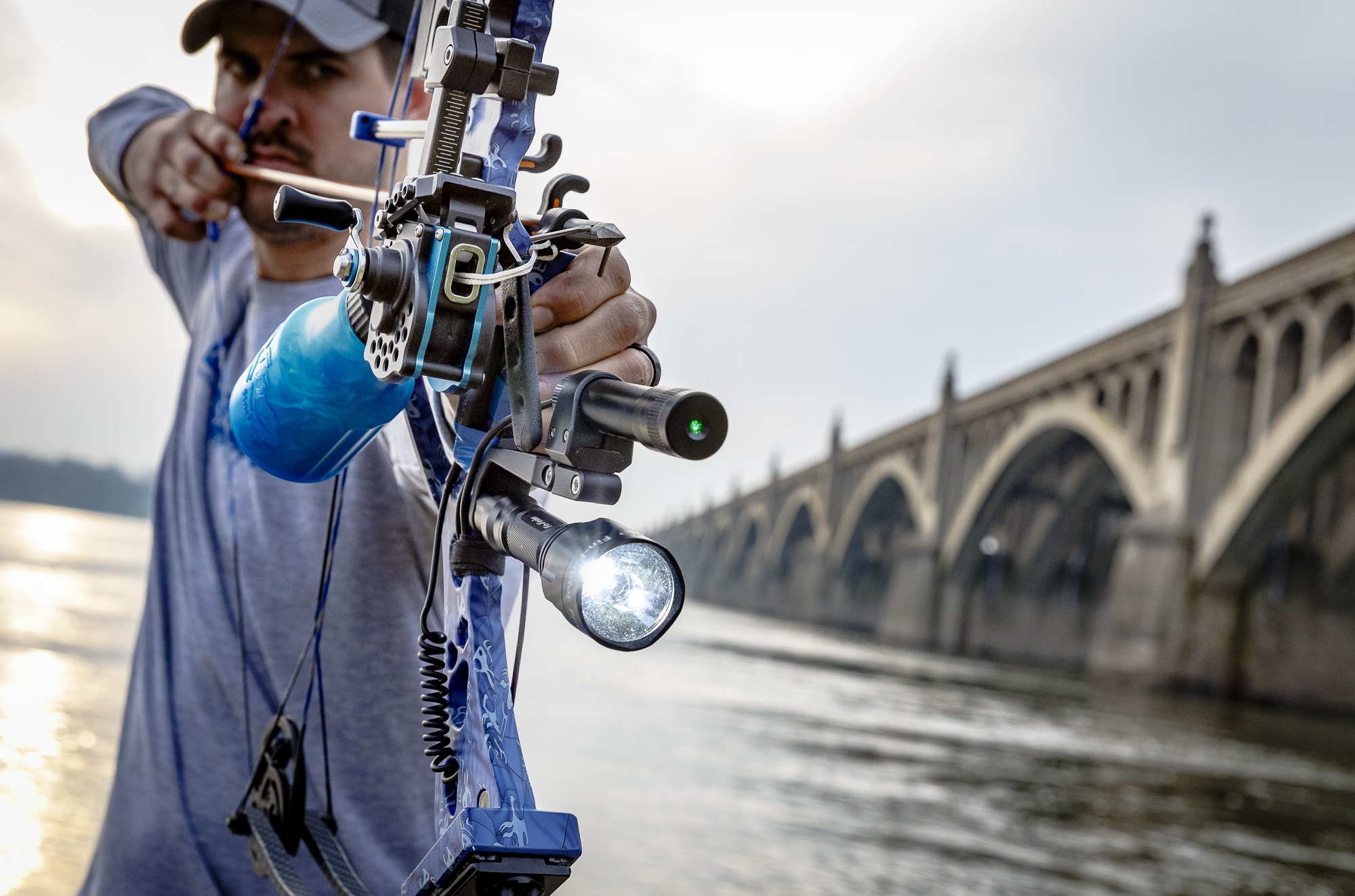
The sport of bowfishing is fun, challenging, frustrating, and most of all – addictive. One of the first hurdles a beginning bowfisherman needs to overcome is how to aim due to the light refraction that occurs in the water.
Simply put, the fish isn’t where it appears to be, so you need to make adjustments in order to consistently hit your target. There are multiple bowfishing sight options and aiming methods that can be used successfully, and you’ll surely find opinions regarding each sight and method.
Keep reading to learn more about the three most common bowfishing sights and aiming methods that are used by bowfishing enthusiasts everywhere.
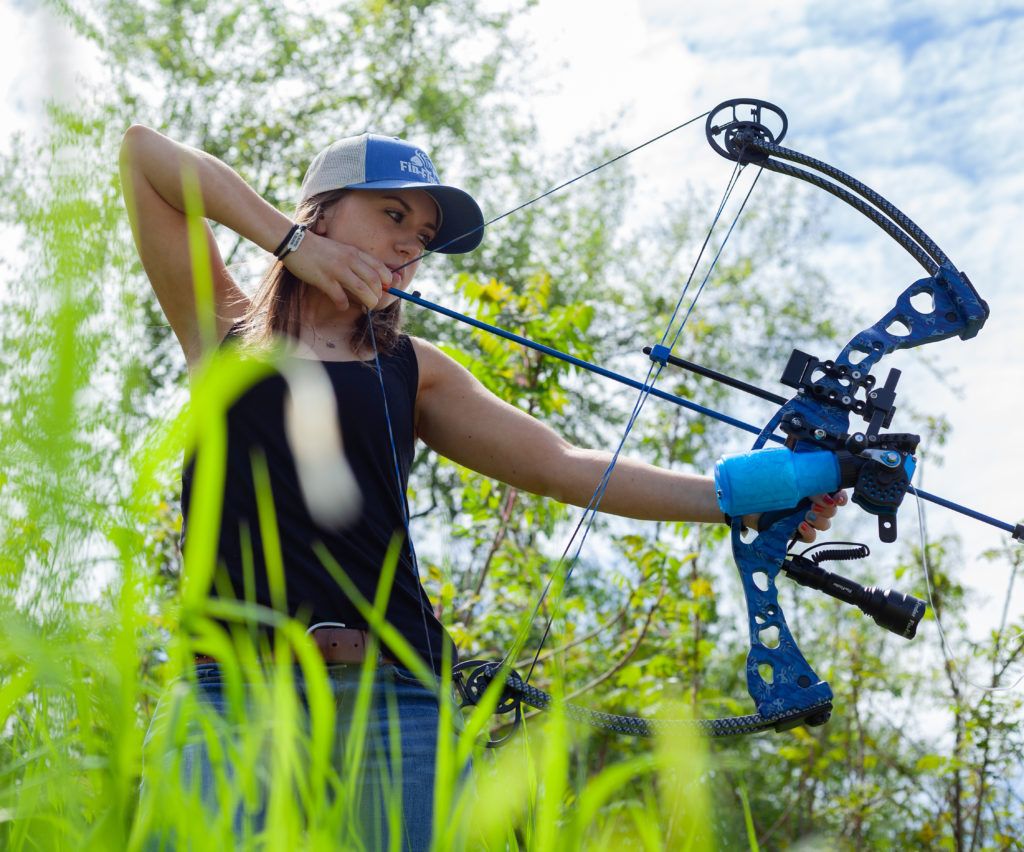
1. Bare Bow
We’d be remiss if we didn’t include shooting without a sight on this list. The fact is, many bow fishermen and women enjoy the challenge of instinctive aiming. This is much akin to the way traditional archers aim with a recurve or longbow.
In many bowfishing situations, the shooting distance is closer than in archery hunting situations, and arguably, aim doesn’t have to be quite as precise.
Pros:
As mentioned, some people love the challenge of shooting with a barebow and so that, in itself, is a positive for them.
However, there are some other benefits to shooting without a sight.
First, bowfishing is a fast-paced sport and requires the shooter to be quick on the draw. Many shooters want a clear and unobstructed sight window so that they more easily see the fish. When employing a snap shooting style of release, being comfortable with instinctive aiming can be the most efficient way to get a shot off fast without the added time to “line up” the sight on the fish.
Skilled bow fishermen who shoot with a barebow can quickly make adjustments in their aim depending upon the depth and distance of the target fish. These benefits are what lead some experienced archers to choose the barebow option while bowfishing.
Cons:
Even with barebow shooting, most shooters will be using some point of reference for their aim, whether it is the tip of the arrow or otherwise. However, without a bowfishing sight as a reference aiming is indeed more challenging.
The shooter has to take into account not only the light refraction in the water, but the distance and depth of the fish.
Some experienced bow fishermen that are proficient with their equipment can do all of that in the blink of an eye without so much as a second thought.
However, this can be especially challenging for the newbies on the boat. In those instances, it is a good idea to have a bow outfitted with some kind of aiming device as another option for that crew member who is having trouble connecting with a fish.
2. Pin Style Sight
There are some single pin bowfishing sights on the market that are essentially a simplified version of a bowhunting sight. Repurposing an old hunting sight can work if you want to add a point of reference for aiming your bowfishing bow as well.
However, if you have a multi-pin hunting sight, you won’t really have use for all those pins, so at least some of them can be removed.
Regardless of the sight and the aiming method you choose, practice is a good idea and can help you avoid missing your target in the moment of truth.
If you are using a pin sight, it is especially beneficial to take some practice shots to get your sight dialed in. A submergible target, such as a Muzzy Gar, is a great option for this.
Remember, when sighting in your bowfishing bow, you will need to adjust your sight so that your point of impact is actually lower than where you aim on the fish. This is also why barebow shooters will aim low on their target.
You can account for this light refraction with a sight, to a degree, but ultimately you need to think of your bowfishing pin sight a bit differently than a bowhunting sight.
Consider it as giving you an additional point of reference for your aim, rather than it being the same level of precision aiming device that a hunting sight becomes once it is dialed in. Variations in the distance and depth of a fish will create the need for aiming adjustments.
Pros:
As we mentioned, a point of reference for aiming can be valuable. If you’re used to hunting with a compound bow, picking up a bowfishing bow that has no sight can feel pretty foreign.
Even if you start out missing some fish, having a sight on your bow naturally allows you to make adjustments from shot-to-shot because you will have greater consistency regarding your point of aim.
Cons:
Aiming with a fixed pin sight takes a bit longer than instinctive shooting and makes a quick draw and release more difficult.
If you’re on a boat with some fast shooters, you might have a difficult time getting the first shot off.
Additionally, the clear sight window that we mentioned as a benefit of barebow shooting will be somewhat obstructed by a pin sight. Furthermore, many hunting sights come with a sight housing that is beneficial to protecting the sight pins and fiber optics while you walk through brush. This sight housing further obstructs the view of your target fish and can make aiming when bowfishing more difficult.
We previously mentioned that it is beneficial to practice with your bowfishing rig, and while that is true, it is important to mention that when your bow is sighted in with a pin sight, the depth and distance of the fish will affect the point of aim.
Adjusting your aim based on these factors will be necessary and there will still be some trial and error involved. Having the pin sight as a point of reference can be helpful, but consistently hitting your target still requires manual adjustments on the fly, and will rely heavily on your proficiency as a shooter.
3. Refracting Laser Sight
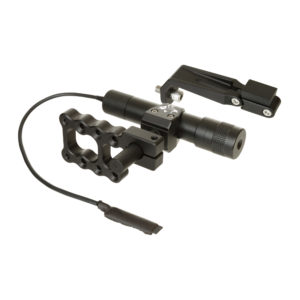
Fin-Finder RefractR BLS™ Bowfishing Laser Sight
When Fin-Finder entered the bowfishing market, our first flagship product was a patented refracting laser bowfishing sight.
Since that time, the design and build of our laser sight has gone through several generations of evolution and in 2019 we launched the RefractR BLS sight.
Refracting laser sights eliminate a lot of the guesswork associated with aiming because the laser refracts in the water so that you can aim directly at the fish.
Pros:
Obviously, you can greatly increase your accuracy, and therefore your hit percentage by using a refracting laser sight.
That is certainly a key benefit of this type of sight option. Additionally, because the laser emits a beam that shows on the fish, it is a faster aiming method in many ways than a pin sight.
The laser makes longer-range shots or shots in deeper waters much easier to accomplish as well. Lasers can be a good option for beginners who are starting in the sport and want to shorten the learning curve. They are also very popular with experienced veterans as well, especially in tournament settings when missing a fish can be costly.
A big benefit to the RefractR laser is that it can be installed on the sight mounts of your bow, or if you prefer a clear sight window, it can be mounted at the bow’s stabilizer bushing.
The RefractR BLS bracket is compatible with a bow-mounted light and can be rotated above the light to position the laser closer to the arrow, providing a greater degree of accuracy. The laser also makes night bowfishing much easier, because the green laser beam is highly visible in dark conditions.
Cons:
Setting up and tuning a refracting laser sight takes more time than just grabbing a barebow and hitting the water.
The setup is not complicated, and the benefit is usually more fish in the boat, but the time can be a factor to consider. It’s also important to remember that the laser is technically exact to the specific depth and distance for which you have sighted it in. So, we advise that you tune the laser according to your bowfishing conditions, in terms of water depth and average shot distance.
If you get on the water and the fish are deeper than usual, a few quick micro-adjustments can easily be made to dial it in. However, these things need to be taken into account when you are experiencing shot variation.
If you plan on bowfishing during a bright sunny day, the laser will still work, but you may notice that the competing sunlight makes the laser less vibrant. Make sure you keep your typical bowfishing conditions at the forefront of your decisions when choosing the right type of sight for you.
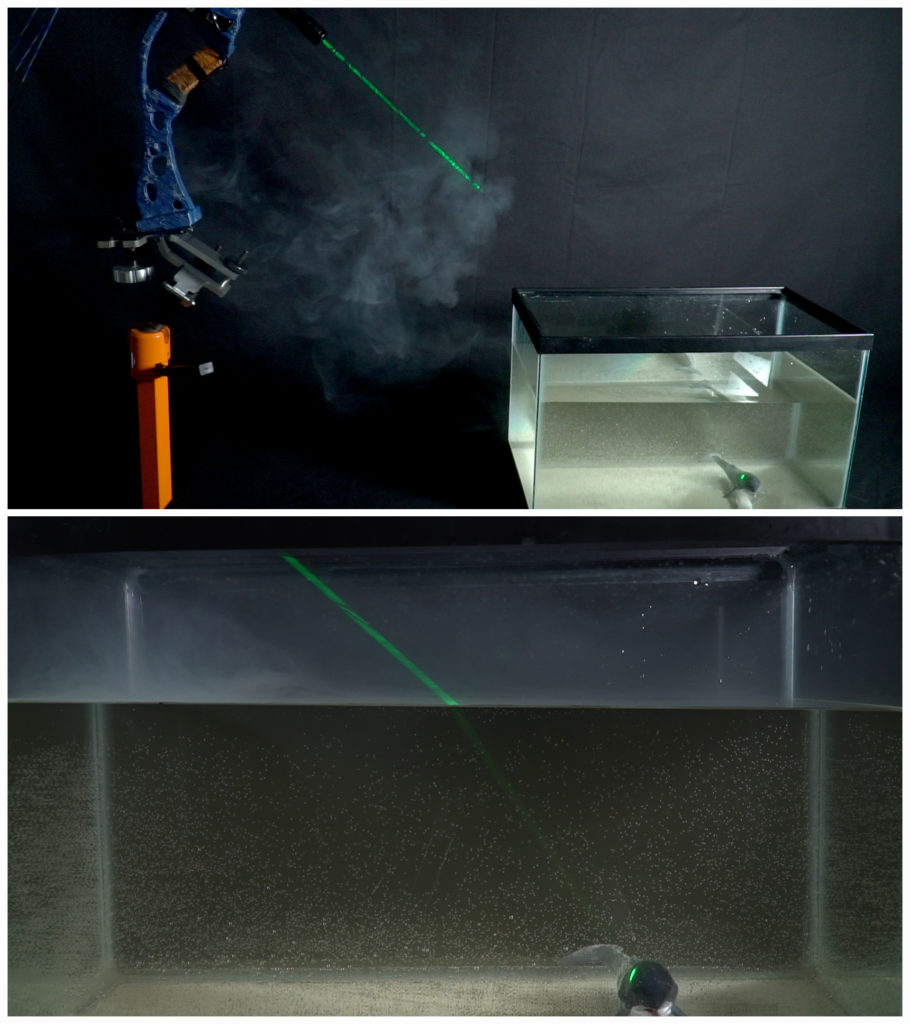
Finally, a refracting laser is indeed a very effective bowfishing tool, and we are aware of the fact that its effectiveness leads some anglers to conclude that it makes things “too easy”. Simply put, there is a lot of diversity in the bowfishing community, and that is why we offer a range of quality products from traditional style barebows to advance compound bow systems and refracting laser sights!
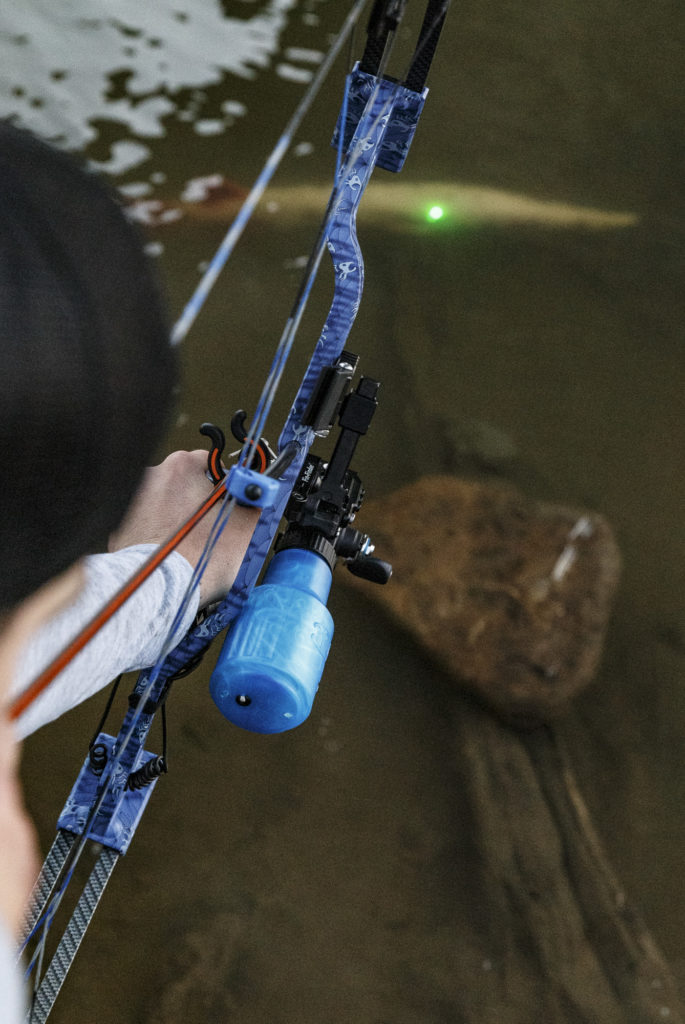
Recap
Choosing the right sight and aiming option for your bowfishing pursuits really comes down to your preferences, your goals, and your experience level.
If someone on the boat has a rig that is set up differently than yours, ask if you can give it a try. Trying out different options is one of the best ways to determine what bowfishing set up is right for you.
And remember, the most important thing is to just get out on the water and start wreckin’!
If you’re interested in more information on any of our latest bowfishing accessories, check out our website. Be sure to connect with us on Facebook, Instagram, and YouTube for more Fin-Finder bowfishing news, updates, contests, and giveaways!

